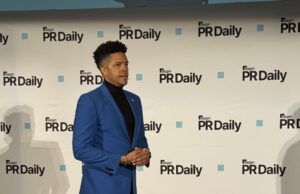10 tips for telling better stories with data
‘Data without insights is chaos.’

Data can tell beautiful stories. Having hard numbers can give credibility to anecdotal stories and elevate a ho-hum business happening to a broader trend story.
But there are major pitfalls to dealing with data, too.
“Data without insights is chaos. It’s too much to digest,” Trovon C. Williams, senior vice president of Marketing and Communications for the NAACP said during Ragan’s recent Future of Communications conference.
Along with fellow panelist Matt Ward, head of Communications for Corebridge Financial, Williams stressed the need to give shape and context to numbers. Getting your hands on cold, hard data is great, but it’s only the first step.
You have to marry data with creativity, Williams said, in order to create a beautiful picture.
Here are 10 tips to do just that.
- Data is only as good as your inputs, Ward said. If the data is flawed, the story will be too. Ensure you’re pulling the right information from the right sources.
- But how exactly do you know what the “right information” is? Ward said that at Corebridge Financial, they just flat-out asked their audiences what kinds of data they’re most interested in. From there, they tied that data to goals, built tactics and then measured. That allowed them to build a story around why their data matters. Your data must have a purpose, Ward advised, that ladders up to something bigger.
- Who are your audiences for data-based storytelling? It can vary widely, from journalists you’re pitching to existing or prospective customers to internal audiences – even your executive leadership.
- Telling stories to leadership helps them contextualize your victories, Williams said. Your CEO might not care that you’ve hit a million Instagram followers, but if you can explain that most of those customers are directly in your demographic sweet spot and are engaging with content, suddenly that milestone means a lot more.
- Make sure you’re customizing data for each individual audience you’re reaching. “Your data allows you to be a smart creator,” Williams said. No one is speaking to a single audience, so use data-driven insights to segment your messaging to your target.
- Authenticity is determining what things you have the right to talk about and own, then using the data to substantiate themes, Ward says. “If you’re meeting people where they are, you have a higher chance of being authentic.”
- Sometimes being authentic means finding the gaps and realizing where you aren’t meeting the moment, Williams says. The NAACP is in history books – and they’ll stay in history books if they don’t read the data right, he said.
- Using the same messaging across platforms is lazy and does not allow us to reach our audiences as we need to, Williams said.
- When you’re working with data, there’s an inclination to include everything. Simplify. Pick one or two points, Ward advises.
- Help news outlets tell the story you want them to tell by providing the data necessary to support it, Williams said.
Numbers can seem cold and matter-of-fact. But in the hands of a skilled communicator, they can form a foundation for stories that appeal to a variety of audiences. It’s merely up to us to coax those stories free and get them in the hands of the right people at the right time.
What are your tips for better storytelling through data?
Allison Carter is editor-in-chief of PR Daily. Follow her on Twitter or LinkedIn.







